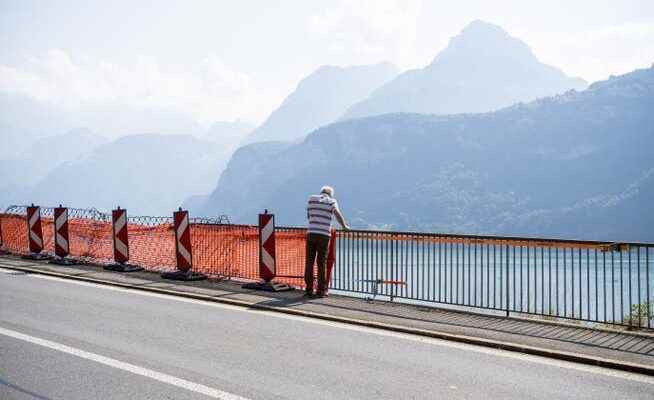The Federal Administrative Court has dismissed a complaint by environmental organizations against the new Axenstrasse project in its entirety. However, it will be a long time before the accident-prone section is cleaned up.
The accident site at the Wolfsprung is just one of the dangerous places on the Axenstrasse.
How dangerous the Axenstrasse between Brunnen (Schwyz) and Flüelen (Uri) is has been shown twice in the past few weeks. The images of the dramatic traffic accident, in which a car crashed into a rock face, crashed into Lake Uri and was rescued from a depth of 182 meters in a complex operation, went around the world. The fact that the approximately 11-kilometre-long road had to be closed again at short notice during the night from Monday to Tuesday due to a rockfall also made headlines.
In connection with the two tragic events, the new Axenstrasse project also attracted more public attention. In fact, since 2014 there has been an implementation project with which this neuralgic point on the national road network should be made safer. The project approved by the Federal Council at the time provides for two new tunnels to be built near Sisikon and Morschach. Practically all notorious accident hotspots and areas threatened by natural disasters would then disappear into the mountain. However, this major project has been blocked by objections from various environmental organizations.
Safety is paramount
After the case had been pending for two years, the Federal Administrative Court (BVGer) in St. Gallen happened to pass a groundbreaking judgment shortly after the tragic accident. It rejected a complaint against the project by the Alpine Initiative, Doctors for Environmental Protection and Swiss Traffic Club (VCS), as the court stated in a press release.
The environmental groups had argued that the Federal Council had wrongly classified the new section of road, which the Federal Assembly had defined as a third-class national road. The new road is no longer planned as a third-class national road (for all road users including non-motorised traffic) like the previous Axenstrasse, but as a new second-class national road (only motor vehicles) built parallel to the existing road. However, the Federal Administrative Court in St. Gallen came to the conclusion that this classification is not objectionable.
The Federal Council has not exceeded its powers, and the classification as such has proven to be permissible for safety reasons, since the use of the tunnels by non-motorised traffic such as cyclists and agricultural vehicles would be too dangerous. In their verdict, the judges emphasized that the route via the old Axenstrasse is still available to slow and local traffic.
The court also had to deal with the question of the extent to which the Alpine Convention should be taken into account when planning the new Axenstrasse. The Federal Administrative Court comes to the conclusion that the norms of the Alpine Convention are not directly applicable as a framework agreement. In addition, the associated traffic protocol cannot be used as a basis, since Switzerland has not yet ratified it. The admissibility of the new Axenstrasse had to be assessed on the basis of national law. This is the first time that the Federal Administrative Court has ruled on the applicability of the Alpine Convention in relation to an infrastructure project.
The environmental organizations had also criticized that the environmental impact assessment should also have taken into account the obligations under the Paris climate agreement. The judges of the Federal Administrative Court do not follow this argument. Since the Swiss electorate supported the total revision of the CO2law, which would have specified the requirements of the Paris climate agreement, only the provisions of the applicable CO2– Act prevails. However, no specific specifications for the project can be derived from this. The court therefore dismisses the complaints in this regard.
Commissioning in 2033 at the earliest
The affected cantons of Schwyz and Uri take note of the verdict with great satisfaction. “The events of the last few days have once again impressively shown that this route is no longer up-to-date in terms of safety, routing and protection against natural hazards,” explains Schwyz construction director André Rüegsegger. The Federal Administrative Court confirmed with its clear judgment that there is a need for action.
In a press release, the intercantonal Axenkomitee, in which the environmental associations have come together, regrets the decision of the Federal Administrative Court to reject the complaint against the new Axenstrasse in its entirety. The complainants were at least able to achieve respect. In its deliberations, the Federal Administrative Court once again clearly states that the new Axenstrasse may only be put into operation once the accompanying measures have been implemented on the existing Axenstrasse.
It is not yet clear whether this verdict is the last word in this matter from a legal point of view. The complaining associations have until mid-September to refer the judgment of the Federal Administrative Court to the Federal Supreme Court. Government Councilor Rüegsegger hopes that this will not be the case. «I rely on the reason of the environmental organizations. The verdict was so clear that it is difficult to objectively justify further resistance to the project.” The complaining organizations will now analyze the verdict in detail and then decide whether to move on.
But even if the legal dispute is now over, it will still be some time before north-south traffic rolls through the two tunnels. After all, work on the construction of a temporary auxiliary bridge began in May of this year in the Gumpisch area, which is particularly threatened by rockfall. Ideally, construction of the actual tunnel work could begin in 2025. The new Axenstrasse could be put into operation and the old route opened for non-motorised traffic from 2033 at the earliest.
